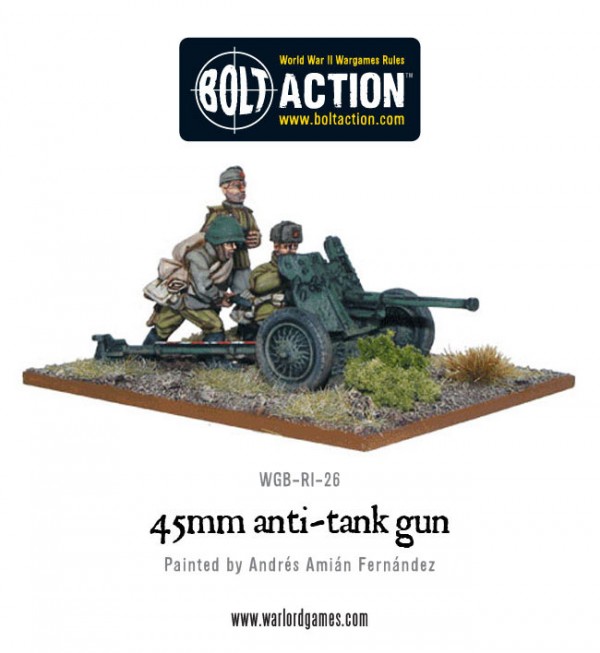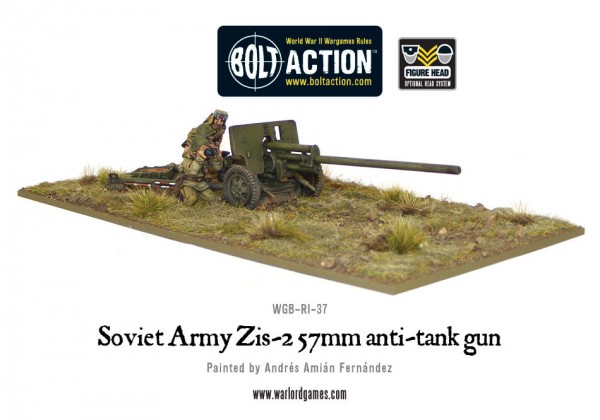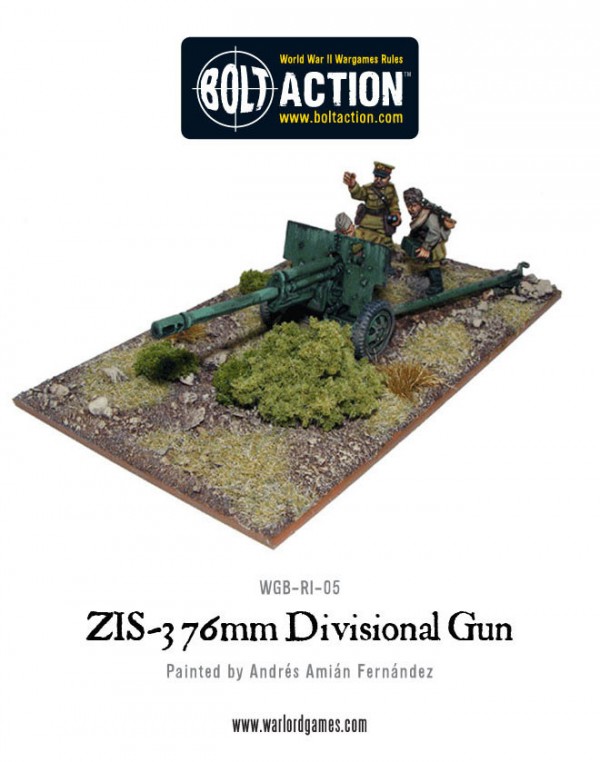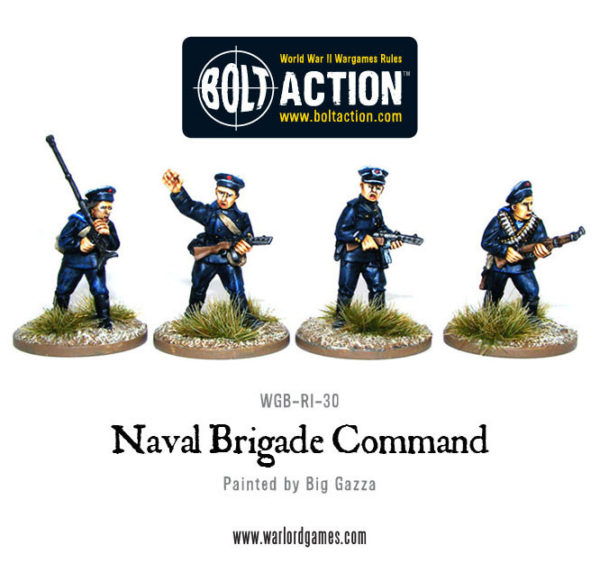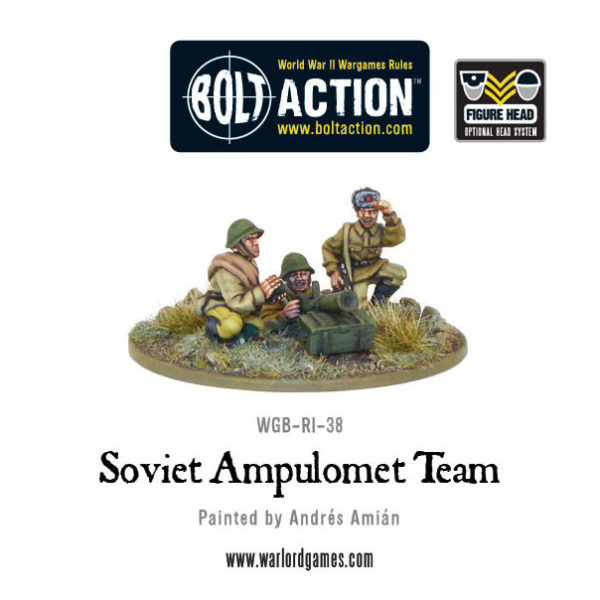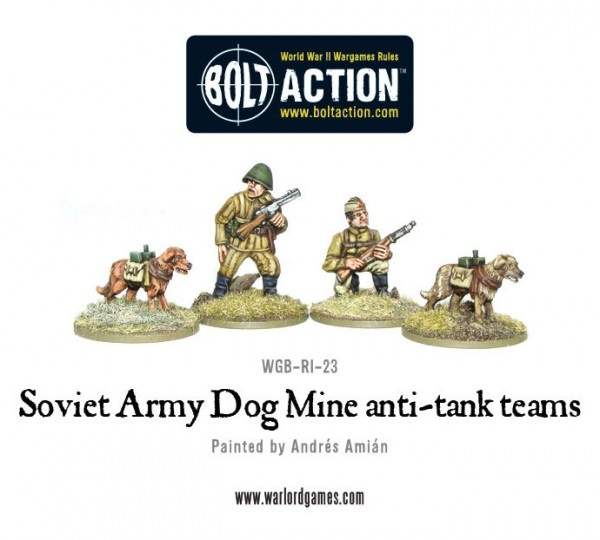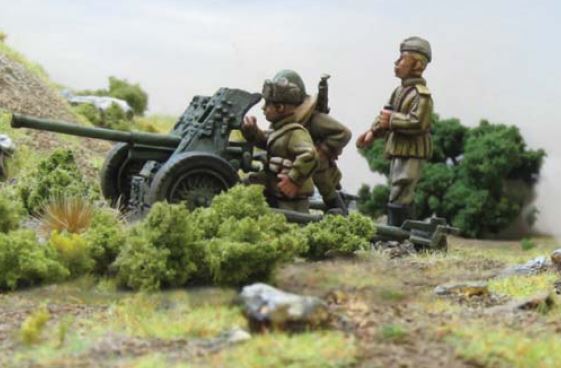
The Soviets preferred method of winning a war was numbers, and lots of them. Large numbers of soldiers were trained, and Russian factories turned out incredible numbers of guns, tanks and vehicles to be thrown at the German battle lines. Here are a selection of Russia’s most well-known and key anti-tank weapons from the war:
45mm gun
The 45mm gun was found all across the Russian Front at company levels. With a low height and light frame, it was an ideal weapon to bring along when tanks were spotted. Like most guns of this size (Pak 38, 6 pdr), it was soon underperforming against the improved German tanks. However, the Russian spirit ensured it still found a use.
Zis-2
The Zis-2, or to give its full title, ‘57-mm anti-tank gun model 1941’, was introduced in 1941. Developers used existing heavy armour (the KV-1 with its 90mm plating) to determine that 57mm would be a large enough calibre for the task at hand. Whilst the gun was very capable of penetrating German armour, Russian Generals were dissatisfied with the damage the shells initially did, simple passing through the tank without much in the way of collateral damage. It found itself in the shadow of the Zis-3, which was better suited for penetrating the likes of the Panther tank. However, once guns such as the aforementioned 45mm proved useless, and the demand for guns rose, the Zis-2 was reintroduced in 1943 (57-mm anti-tank gun model 1943). By the end of the war over 10,000 units were made. The gun was also used on a few tanks, including the T-34-57, prototype SU-76s, and the Zis-30 tank destroyer (a new model of this one will be coming soon!).
Zis-3
Following on from the Zis-2 was the Zis-3, a 76mm divisional gun with bigger shells and more power. This field gun was a combination of the Zis-2’s wheeled carriage and another gun, the F-22USV, with added features like a muzzle brake. The first gun made was hidden from Soviet authorities, who believed that such guns weren’t necessary at the time (also, state authorities were not informed of the project – a rather dangerous secret to keep in Stalinist Russia!). However, once German armour improved, the guns were demanded by Soviet officials, and full production commenced. Distribution was hampered by the refusal of some to accept a non-sanctioned and untested weapon, but once the gun got the approval of officials (Stalin was impressed by the guns performance during testing) it was fully integrated by 1942. Platoons of Zis-3 were made up of three batteries, each containing four guns and their crew.
In terms of performance it far outclassed previous efforts, being capable of penetrating armour up to 82mm thick (at 100m). The gun did begin to show signs of struggling when the Tiger made its first appearance on the Eastern lines, but it was still capable of taking on more common medium tanks like the Panzer III and IV. The Germans were keen to grab a few, retooling them to take German ammo and naming them the 7.32cm PaK 37(r) and 7.32cm PaK 39(r). Captured guns were occasionally used in the creation of Marders.
Over 103,000 units were produced during the war, cementing this weapon’s place in history as an important tool of warfare.
PTRD Anti-Tank Rifle
The PTRD 41, (shortened from Protivo Tankovoye Ruzhyo Degtyaryova, or Degtyaryov Anti-Tank Rifle) was one of the only individually available anti-tank guns used by the Soviets. Before 1941, when the PTRD (shown above as part of our Soviet Naval Brigade command pack) was introduced, the Red Army relied mostly on captured Polish rifles. Based on these captured guns, and elements of the German Panzerbüchse 38, The Russians developed their own single-shot rifle. The two metre-long gun fired a 14.5mm bullet as speeds exceeding 1,000 metres per second.
Whilst ineffective against most frontal armour, the PTRD was effective against lighter side armour, transports and soft-topped self-propelled guns. Against the Panzer IV and similar tanks, soldiers had to be practically at point-blank range to be able to get through, which was always a hazardous venture. The gun was produced until the end of the war, but found a use in Soviet armies up until the 1960s.
Ampulomet
This unusual weapon was found in Red Army for only a year or so, but it stands out as one of the Soviet’s more interesting contraptions. Firing a 125mm 1.5kg ball-like projectile made of glass in a similar fashion to a mortar, this incendiary weapon was used against enemy armour at ranges of up to 300m. The glass baubles it fired were far more deadly than those found on Christmas trees, and were filled with highly volatile and flammable chemicals, which were not lit by the user, rather by means of a chemical reaction or impact (it’s not 100% known which it was). The weapons themselves were made out of anything the Soviets could find: mainly comprised of a few bits of metal and a large tube for the projectile.
Based on its unusual payloads, the Ampulomet had a mixed effectiveness. It was a brutal weapon when used on open-topped vehicles like the Hanomag and Kubelwagen, where the fiery concoction would go about its horrific work. Against fully-armoured tanks, it was less effective, though it worked well on engine decks and if aimed at the vision slits, the burning liquid would surely cause severe burns to a tank’s crew.
The gun saw limited action since its 1941 introduction, dying out of common usage a year later once proper mortars and anti-tank guns were produced and distributed.
Bomb Dogs
To top this list off is one of the more unusual anti-tank weapons, the bomb dog. Officially introduced in 1935 and used up until 1942, the intention was to have the dog approach an armoured vehicle, drop off the explosive device, and run back to the handler before it detonated. Sadly this was not always the case, as after six months of training it was found that no dog could manage the task. So it came to be that the device was detonated via an impact detonation trigger, taking the dog with it. The soviet army didn’t have a dedicated training school, and so used hunters and police to help train the dogs. The favoured breed was the German Shepherd, but many other kinds were used for this one-way attack.
Dogs were trained by making them hungry, and attaching food to the underside of training tanks (the weakest points), thus associating the two in the mind of the dog. However, this cruel and unconventional tactic had many problems. Firstly, many dogs were too scared to go underneath moving and firing tanks, as they had mainly trained on stationary and non-firing tanks (in a fuel/ammo saving measure enforced by Soviet officials). Some even ran back to Russian lines and detonating amidst the troops. Dogs were often shot to prevent this, but trainers would often refuse to train any further dogs after the ordeal. Another serious issue was that the dogs were trained using Soviet diesel powered tanks not enemy gasoline-powered ones. This meant that the dogs would be attracted to the wrong vehicles via their strong sense of smell. Common use of bomb dogs fell rapidly by 1942, though it is still claimed that over 300 enemy tanks were disabled by them. For animal lovers reading this, dogs were soon found less horrific (but no less dangerous) roles in the Soviet army, as mine-detecting dogs and for deliveries.
Knowing a little more about the guns we use in our games undoubtedly gives us an appreciation for the development that went into them, and allows us to mimic their use for the ultimate historical experience.
Check out the full Soviet Army range:

